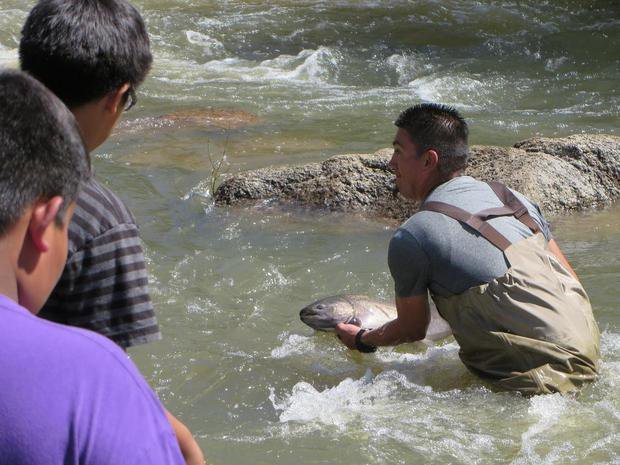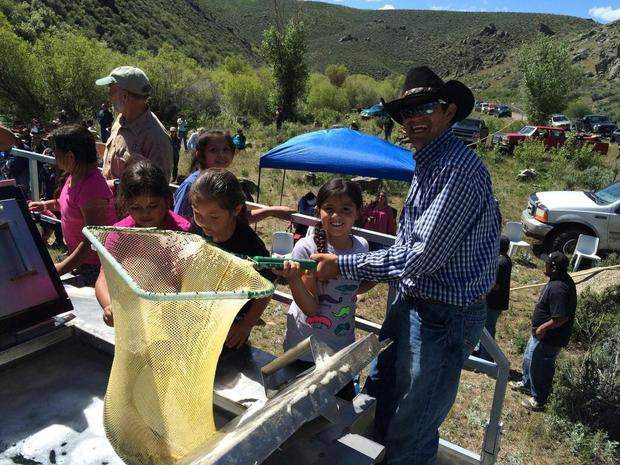After 87 Years, Salmon Return to the Shoshone-Paiute Reservation
- September 10, 2015
- John Harrison

This summer, for the first time since 1928, salmon swam in the Owyhee River on the Duck Valley Reservation of the Shoshone-Paiute Tribes, and tribal members fished for them – some using traditional wooden fishing spears.
It was an historic event, made possible by the collaboration of the tribe, the Idaho Department of Fish and Game, the Northwest Power and Conservation Council, the Shoshone Bannock Tribe of the Fort Hall Reservation, Idaho Power Company, and others. Tribal members and their families, including tribal youth, participated in the fishery, which began May 28 and lasted into July.
A total of 199 spring Chinook salmon were collected in a trap on the Snake River below Hells Canyon Dam, held temporarily at the Rapid River Hatchery near Riggins, Idaho, then released into the Owyhee on the reservation. Weirs confined the fish to a five-mile stretch of the river. The organizers hope the 2015 fishery will be the first of many annual fisheries in the future.
Buster Gibson, vice chairman of the Shoshone Paiute Tribes Business Council, Jinwon Seo, the tribes’ fish and wildlife director, and Sam Sharr, anadromous fish coordinator for the Idaho Department of Fish and Game, reported on the fishery at the Power Council’s September meeting this week in Eagle, Idaho.
“This was a hugely anticipated event,” Gibson said. “It brought new hope for a lot of people.” Gibson said four of his five children speared salmon, including his six-year-old son whose fish “was about as big as him.” Gibson added, “for me, it’s still hard to talk about; my father, grandfather, and great grandfather talked about salmon since I was a kid. It’s been my passion to work on this, I was there day and night.”
Idaho Council Member Jim Yost, who helped guide and coordinate the 2015 reintroduction, said, “we’re taking this a step at a time; it’s the collective effort of everyone working together, doing what you can. The important thing is we've got the tribe started.”
While the fishery was important to the adult tribal members, Seo said perhaps the biggest impact was on children who, wide-eyed and excited, had never seen anything like the release and capture of the big, greenish-brown fish. “There are no words to describe the happiness, the kids shouting,” he said. “They were the choir. It was a truly joyous day.”
The Shoshone Paiute Tribes occupy the 289,819-acre Duck Valley Reservation, which straddles the Idaho-Nevada border 130 miles south of Boise. The original reservation was established by presidential order in 1877 and expanded in 1886 and 1910. Salmon once migrated from the Pacific Ocean up the Columbia, Snake, and Owyhee rivers into Nevada, a distance of nearly 900 miles. But construction of dams on the Owyhee and Snake rivers blocked their migration, and the last salmon run into the reservation was in 1928.
The fishery of the summer of 2015 was an emotional as well as an historic event for the Shoshone-Paiute Tribes, particularly for tribal elders who are just a generation removed from the last people to fish for salmon on the reservation. The day before the fish were released into the river, the tribe sponsored a spearing workshop to teach traditional fishing methods.

A beaming Buster Gibson, vice chairman of the Shoshone Paiute Tribes Business Council, dips a Chinook salmon out of an Idaho Department of Fish and Game truck to release into the Owyhee River on the Duck Valley Indian Reservation.
Photo: Jeff Allen, Northwest Power and Conservation Council
Links:
Upper Snake River Tribes Foundation



